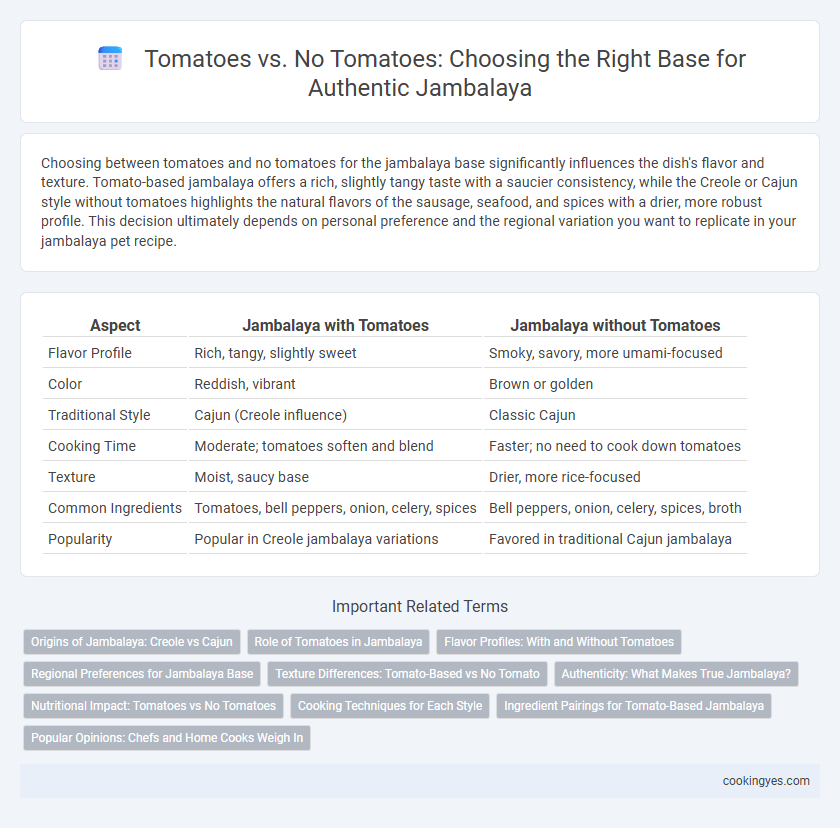Choosing between tomatoes and no tomatoes for the jambalaya base significantly influences the dish's flavor and texture. Tomato-based jambalaya offers a rich, slightly tangy taste with a saucier consistency, while the Creole or Cajun style without tomatoes highlights the natural flavors of the sausage, seafood, and spices with a drier, more robust profile. This decision ultimately depends on personal preference and the regional variation you want to replicate in your jambalaya pet recipe.
Table of Comparison
| Aspect | Jambalaya with Tomatoes | Jambalaya without Tomatoes |
|---|---|---|
| Flavor Profile | Rich, tangy, slightly sweet | Smoky, savory, more umami-focused |
| Color | Reddish, vibrant | Brown or golden |
| Traditional Style | Cajun (Creole influence) | Classic Cajun |
| Cooking Time | Moderate; tomatoes soften and blend | Faster; no need to cook down tomatoes |
| Texture | Moist, saucy base | Drier, more rice-focused |
| Common Ingredients | Tomatoes, bell peppers, onion, celery, spices | Bell peppers, onion, celery, spices, broth |
| Popularity | Popular in Creole jambalaya variations | Favored in traditional Cajun jambalaya |
Origins of Jambalaya: Creole vs Cajun
Creole jambalaya traditionally includes tomatoes, reflecting the French and Spanish influences found in New Orleans cuisine, while Cajun jambalaya omits tomatoes, showcasing the rural, rustic flavors of southwestern Louisiana. The presence of tomatoes in Creole jambalaya produces a tangier, stew-like base, contrasting with the spicier, earthy profile of Cajun jambalaya that relies on browned meat and rich spices. These regional differences highlight the diverse cultural origins and cooking techniques distinctive to Creole and Cajun communities.
Role of Tomatoes in Jambalaya
Tomatoes in jambalaya contribute a rich, tangy depth that enhances the stew's complexity and balances the bold spices. While traditional Creole jambalaya often includes tomatoes, providing a slightly sweet acidity and vibrant color, Cajun-style typically omits them, focusing on a roux-based, smoky flavor profile. The choice between using tomatoes or not ultimately influences the dish's flavor intensity, texture, and visual appeal, shaping the regional authenticity of jambalaya.
Flavor Profiles: With and Without Tomatoes
Jambalaya with tomatoes offers a rich, tangy flavor profile that enhances the dish's depth and adds a subtle sweetness balancing the spices. Without tomatoes, the base relies on a more savory, smoky essence from ingredients like andouille sausage and creole seasoning, allowing the natural flavors of the meat and rice to shine. Choosing tomatoes creates a vibrant, slightly acidic foundation, while omitting them results in a more traditional, hearty, and robust taste.
Regional Preferences for Jambalaya Base
Cajun jambalaya traditionally excludes tomatoes, emphasizing a roux-based sauce with smoked sausage, chicken, and the "holy trinity" of onions, bell peppers, and celery, reflecting Louisiana's west-central region culinary style. Creole jambalaya, primarily from New Orleans and eastern Louisiana, incorporates a tomato-based sauce, adding a tangy depth that highlights French and Spanish influences. Regional preferences for the jambalaya base highlight a cultural divide: tomatoes dominate in Creole variants, while Cajun versions favor rich, brown roux without tomatoes.
Texture Differences: Tomato-Based vs No Tomato
Tomato-based jambalaya offers a rich, saucy texture that coats the rice and ingredients with a thick, slightly tangy consistency, enhancing moisture and depth in each bite. In contrast, no-tomato jambalaya, often known as Creole or Cajun style, features a drier, more rice-forward texture where the grains remain distinct and the flavors come from sauteed vegetables, spices, and broth absorption. The choice between tomato and no-tomato bases significantly impacts the mouthfeel, with tomatoes creating a softer, more cohesive dish and no-tomato recipes delivering a firmer, fluffier texture.
Authenticity: What Makes True Jambalaya?
Authentic jambalaya depends on regional traditions, with Creole jambalaya typically incorporating tomatoes, lending a rich, tangy base, while Cajun jambalaya omits tomatoes, relying on browned meat and a smoky, spiced stock for depth. The choice between tomatoes or no tomatoes fundamentally distinguishes Creole jambalaya from its Cajun counterpart, reflecting historical and cultural influences in Louisiana cuisine. True jambalaya embraces these variations, highlighting the importance of local ingredients and cooking methods that define each style's authenticity.
Nutritional Impact: Tomatoes vs No Tomatoes
Tomatoes in jambalaya provide essential nutrients such as vitamin C, potassium, and antioxidants like lycopene, which support immune function and heart health. A no-tomato jambalaya base reduces these nutrients but lowers the dish's acidity, benefiting those with sensitive stomachs. Choosing between tomato or no-tomato bases impacts not only flavor but also the overall nutritional profile, influencing vitamin intake and antioxidant levels.
Cooking Techniques for Each Style
Jambalaya with tomatoes, often found in Creole-style recipes, relies on slow simmering to integrate the acidity and sweetness of tomatoes, enhancing depth and richness in the base. In contrast, the Cajun-style jambalaya without tomatoes emphasizes sauteing the "holy trinity" of onions, bell peppers, and celery to build a robust, smoky foundation before adding rice and stock. Each technique impacts texture and flavor, with tomato-based bases yielding a saucier, tangier dish, while the tomato-free version produces a drier, earthier jambalaya.
Ingredient Pairings for Tomato-Based Jambalaya
Tomato-based jambalaya features a rich, tangy sauce that pairs perfectly with smoked sausage, chicken, and shrimp to balance its acidity. Onions, bell peppers, and celery--known as the "holy trinity"--enhance the depth of flavor by complementing the tomato base. Fresh herbs like thyme and bay leaves, along with spices such as cayenne and paprika, intensify the savory profile, creating a well-rounded and vibrant dish.
Popular Opinions: Chefs and Home Cooks Weigh In
Many chefs and home cooks debate the use of tomatoes in jambalaya, with Creole versions often including tomatoes for a rich, tangy base that enhances complexity, while Cajun recipes typically omit them to preserve a more robust, smoky flavor. Some culinary experts argue that tomatoes can mask the natural spices and sausage flavors, favoring a clear broth foundation instead. Others believe that adding tomatoes provides a balanced acidity and depth that elevates the overall dish, demonstrating regional and personal preferences in traditional jambalaya preparation.
Tomatoes vs No Tomatoes for Jambalaya base Infographic

 cookingyes.com
cookingyes.com